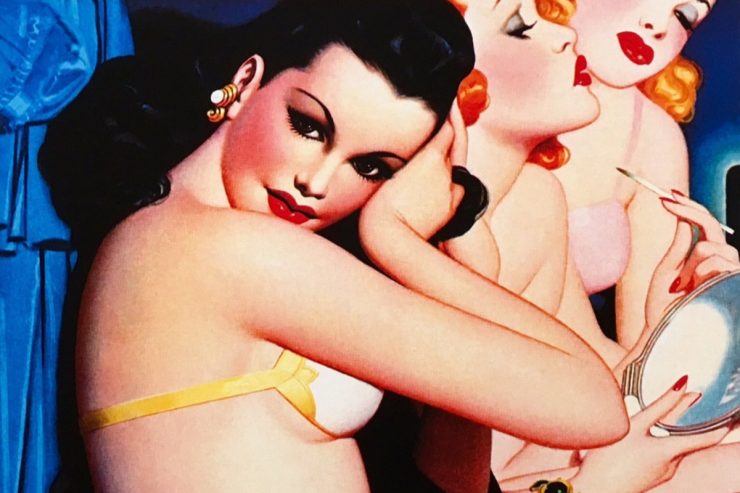Due to a medical emergency in the immediate family of one of our presenters, “Love in the Shadows — The Art of Earle K. Bergey and Enoch Bolles” will not take place at PulpFest 2021. We hope to reschedule it for a future convention. Please accept our apologies.
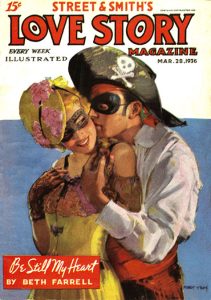 PulpFest returns in August to the Doubletree by Hilton Hotel Pittsburgh-Cranberry in Mars, Pennsylvania for a celebration of “Love in the Shadows.”
PulpFest returns in August to the Doubletree by Hilton Hotel Pittsburgh-Cranberry in Mars, Pennsylvania for a celebration of “Love in the Shadows.”
If you’ve been reading our posts since October 2020, you already know that our theme celebrates the centennial of the launch of Street & Smith’s LOVE STORY MAGAZINE, and the 90th anniversary of the debut of THE SHADOW MAGAZINE, the first hero pulp.
But there’s another way to interpret our 2021 theme.
During the first half of the twentieth century, pulps were one of the leading sources of entertainment for fiction readers across the country. Pulp readers could lose themselves in adventure yarns, stories of mystery and the supernatural, and tales of heart-wrenching love and romance. By and large, the early pulps offered wholesome entertainment that could be enjoyed by the entire family.
Not long after the pulp industry began emerging and expanding in such magazines as THE ARGOSY, THE POPULAR MAGAZINE, THE ALL-STORY MAGAZINE, and THE MONTHLY STORY MAGAZINE, a “seedier” kind of pulp was born. Rather than “Big, Clean Stories of Outdoor Life” and other varieties of wholesomeness, SNAPPY STORIES, THE PARISIENNE, and BREEZY STORIES offered sex and scandal. Featuring “Live Wire Fiction” and “Chic, Amusing, Illustrated Fiction,” these pulps were the forebearers of the girlie magazines and the spicies.
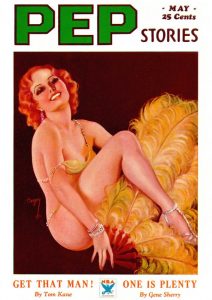 In his introduction to UNCOVERED, THE HIDDEN ART OF THE GIRLIE PULPS,” author Doug Ellis writes:
In his introduction to UNCOVERED, THE HIDDEN ART OF THE GIRLIE PULPS,” author Doug Ellis writes:
Throughout their run, they were attacked by those who felt their pin-up covers, spicy fiction, and nude photographs weakened public morals. Banned in some cities, sold with covers torn off in others, always sold under the counter — when they could be sold at all — the girlie pulps led a precarious life. Month after month, they were furtively sold at newsstands, cigar shops, and burlesque shows . . .
Hidden from the view of the most delicate eyes, they offered, “Love in the Shadows.”
Issue after issue their covers showcased the talents of the finest pin-up artists of their time. Earle K. Bergey, Enoch Bolles, Peter Driben, Jack Greiner, Norman Saunders, H. J. Ward, and others created a body of work that compares favorably to the magazine and calendar pin-up art of the 1940s and 1950s.
On Friday, August 20, join PulpFest 2021 as we welcome Joshua David Bergey and Jack Raglin for “Love in the Shadows — The Art of Earle K. Bergey and Enoch Bolles.”
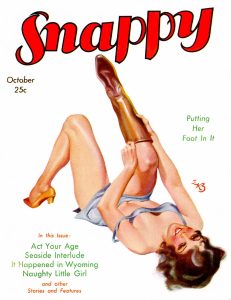 Born in Philadelphia on August 26, 1901, Earle K. Bergey apprenticed himself to professional, teaching illustrators before completing formal studies at the Pennsylvania Academy of the Fine Arts. While producing commercial art for numerous periodicals and newspapers, Earle began to contribute cover art to BRIEF STORIES and PARIS NIGHTS, as early as 1926. He also painted covers for SENTIMENTAL STORIES, a short-lived pulp that featured “Clean Love Stories.” By decade’s end, he was selling regularly to the Fiction House pulps, painting covers for their adventure, aviation, boxing, detective, romance, and western lines.
Born in Philadelphia on August 26, 1901, Earle K. Bergey apprenticed himself to professional, teaching illustrators before completing formal studies at the Pennsylvania Academy of the Fine Arts. While producing commercial art for numerous periodicals and newspapers, Earle began to contribute cover art to BRIEF STORIES and PARIS NIGHTS, as early as 1926. He also painted covers for SENTIMENTAL STORIES, a short-lived pulp that featured “Clean Love Stories.” By decade’s end, he was selling regularly to the Fiction House pulps, painting covers for their adventure, aviation, boxing, detective, romance, and western lines.
 The early 1930s found Bergey expanding more into the so-called girlie pulps, first with SNAPPY and, later, to GAY BOOK MAGAZINE, GAY PARISIENNE, LA PAREE STORIES, PEP STORIES, SPICY STORIES, and many others. He also entered the sports pulp market and increased his exposure in the love pulps. The following decade found Bergey heavily involved with Standard Magazines’ science fiction and fantasy lines, painting many covers for CAPTAIN FUTURE, FANTASTIC STORY MAGAZINE, SPACE STORIES, STARTLING STORIES, STRANGE STORIES, and THRILLING WONDER STORIES.
The early 1930s found Bergey expanding more into the so-called girlie pulps, first with SNAPPY and, later, to GAY BOOK MAGAZINE, GAY PARISIENNE, LA PAREE STORIES, PEP STORIES, SPICY STORIES, and many others. He also entered the sports pulp market and increased his exposure in the love pulps. The following decade found Bergey heavily involved with Standard Magazines’ science fiction and fantasy lines, painting many covers for CAPTAIN FUTURE, FANTASTIC STORY MAGAZINE, SPACE STORIES, STARTLING STORIES, STRANGE STORIES, and THRILLING WONDER STORIES.
In the later 1940s, Earle K. Bergey began to contribute cover art to the Thrilling Group’s Popular Library line of paperbacks. Bergey’s painting for GENTLEMEN PREFER BLONDES, written by Anita Loos, is his best-known paperback cover. He also painted covers for true crime, humor, physical culture magazines, and the slicks, including THE SATURDAY EVENING POST.
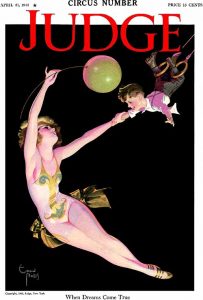 Florida-born Enoch Bolles became a professional illustrator about a dozen years before Earle K. Bergey. A student of New York’s National Academy of Design and the Art Student’s League, Bolles sold his first covers in 1914 to JUDGE and PUCK, both humor magazines. Soon becoming known for painting “All-American beauties precisely posed in wildly imaginative costumes,” he became known as the “Art Deco pin-up master.”
Florida-born Enoch Bolles became a professional illustrator about a dozen years before Earle K. Bergey. A student of New York’s National Academy of Design and the Art Student’s League, Bolles sold his first covers in 1914 to JUDGE and PUCK, both humor magazines. Soon becoming known for painting “All-American beauties precisely posed in wildly imaginative costumes,” he became known as the “Art Deco pin-up master.”
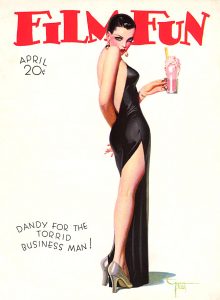 In 1922, Bolles became the exclusive cover artist for FILM FUN, continuing in that role for twenty-one years. He painted over 200 covers for the magazine and more than 300 for the spicy pulps. These included BEDTIME STORIES, BREEZY STORIES, CUPID’S CAPERS, GAY BOOK MAGAZINE, GAY PARISIENNE, HOLLYWOOD NIGHTS, PEP STORIES, SNAPPY, SPICY STORIES, STOLEN SWEETS, and TATTLE TALES. The artist also painted a single cover for Dell Publishing’s SCREEN ROMANCES — a long-lived magazine that featured photo-illustrated novelized versions of popular films — and two covers for TALKING SCREEN magazine.
In 1922, Bolles became the exclusive cover artist for FILM FUN, continuing in that role for twenty-one years. He painted over 200 covers for the magazine and more than 300 for the spicy pulps. These included BEDTIME STORIES, BREEZY STORIES, CUPID’S CAPERS, GAY BOOK MAGAZINE, GAY PARISIENNE, HOLLYWOOD NIGHTS, PEP STORIES, SNAPPY, SPICY STORIES, STOLEN SWEETS, and TATTLE TALES. The artist also painted a single cover for Dell Publishing’s SCREEN ROMANCES — a long-lived magazine that featured photo-illustrated novelized versions of popular films — and two covers for TALKING SCREEN magazine.
An extremely versatile and prolific artist, Bolles was employed extensively by the advertising industry, creating hundreds of advertisements for a variety of products, including Sun-Maid Raisins and Zippo lighters.
“Love in the Shadows — The Art of Earle K. Bergey and Enoch Bolles,” will take place at the DoubleTree by Hilton Hotel Pittsburgh – Cranberry, on Friday, August 20, beginning at 9:45 PM.
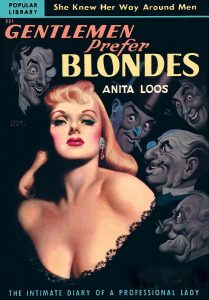 Joshua David Bergey is the grandson of the late Earle K. Bergey. A graduate of Oberlin College, Joshua is a professional writer and artist. He has also worked in higher education, most recently as a dean at a college of visual arts. He has traveled throughout East Asia, Europe, and the Balkans, performing with an absurdist theater troupe and leading an extensive series of essay-writing workshops. He has consulted as an editor of film, facilitated readings for theater, and helped to oversee staged performances and workshops of original scripts by acclaimed writers.
Joshua David Bergey is the grandson of the late Earle K. Bergey. A graduate of Oberlin College, Joshua is a professional writer and artist. He has also worked in higher education, most recently as a dean at a college of visual arts. He has traveled throughout East Asia, Europe, and the Balkans, performing with an absurdist theater troupe and leading an extensive series of essay-writing workshops. He has consulted as an editor of film, facilitated readings for theater, and helped to oversee staged performances and workshops of original scripts by acclaimed writers.
The authority on the life and work of Earle K. Bergey, Joshua teaches and lectures in the field of 20th-century American illustration art. His expertise is sought by universities, colleges, galleries, and museums. Joshua is nearing completion of a book-length work of narrative non-fiction that reveals “the story of the most elusive giant in the field of American illustration and the fascinating, extravagant, even brutal culture behind America’s most jaw-dropping magazine art.”
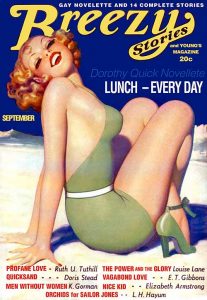 Jack Raglin is a professor in the department of kinesiology at Indiana University in Bloomington. He is a fellow of the American College of Sports Medicine, the American Academy of Kinesiology and Physical Education, and the American Psychological Association. His research involves integrating the use of psychological and physiological variables to examine various issues in sport and exercise, including overtraining, pre-competition anxiety, performance, exercise behavior and adherence, and the relationship between exercise and mental health.
Jack Raglin is a professor in the department of kinesiology at Indiana University in Bloomington. He is a fellow of the American College of Sports Medicine, the American Academy of Kinesiology and Physical Education, and the American Psychological Association. His research involves integrating the use of psychological and physiological variables to examine various issues in sport and exercise, including overtraining, pre-competition anxiety, performance, exercise behavior and adherence, and the relationship between exercise and mental health.
Jack also happens to be the leading authority in the world on artist Enoch Bolles. Raglin’s “Beauty by Design: The Art of Enoch Bolles,” appeared in ILLUSTRATION #9. It was published in February 2004. He is currently working on a biography of the artist. You’ll find Jack’s Enoch Bolles blog at enochbolles.blogspot.com/.
His paintings look like they could have been done yesterday. I’m also attracted to Bolles’ many strengths as an illustrator, particularly the poster-like qualities of his work and his eye-popping palette. Finally, aside from the obvious fact that his girls are attractive, I get the impression from his work that he must have liked and admired women, and I think that’s why Bolles has so many female fans.
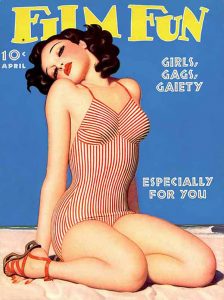 The general public is welcome to attend our evening programming events. To learn more about our programming schedule, please click the Programming button at the top of this page.
The general public is welcome to attend our evening programming events. To learn more about our programming schedule, please click the Programming button at the top of this page.
For those who also want to enjoy our dealers’ room, you can join PulpFest 2021 by clicking the Registration button at the top of this page. And don’t forget to book a room at the DoubleTree. They’re going fast!
Looking back to last October, we celebrated Halloween with Modest Stein’s cover art for the March 28, 1936 issue of LOVE STORY MAGAZINE. It was, most likely, a Mardi Gras number, but the masks and costumes could certainly have been worn again at Halloween. Plus, they’re particularly useful for “Love in the Shadows.”
This year at PulpFest, we’re celebrating “Love in the Shadows.” Meant to be a celebration of the anniversaries of Street & Smith’s popular LOVE STORY MAGAZINE and THE SHADOW, it’s also a suitable theme for a look at girlie pulp artists Earle K. Bergey and Enoch Bolles. “Banned in some cities, sold with covers torn off in others, always sold under the counter . . . the girlie pulps led a precarious life “in the shadows.”
 Earle K. Bergey painted the cover art for the May 1934 PEP STORIES, the October 1931 SNAPPY, the March 1951 STARTLING STORIES, the Popular Library edition of GENTLEMEN PREFER BLONDES, by Anita Loos, and the August 1934 issue of GAY PARISIENNE.
Earle K. Bergey painted the cover art for the May 1934 PEP STORIES, the October 1931 SNAPPY, the March 1951 STARTLING STORIES, the Popular Library edition of GENTLEMEN PREFER BLONDES, by Anita Loos, and the August 1934 issue of GAY PARISIENNE.
Our other “Love in the Shadows” artist, Enoch Bolles, painted the cover art for the December 1941 FILM FUN (our featured image), the April 21, 1923 issue of JUDGE, the April 1935 FILM FUN, the September 1937 BREEZY STORIES, and the April 1940 FILM FUN.

